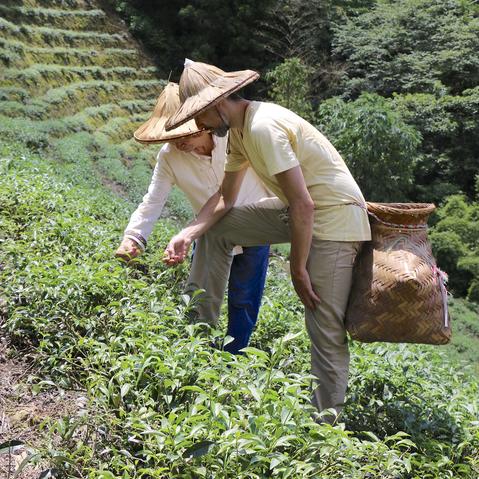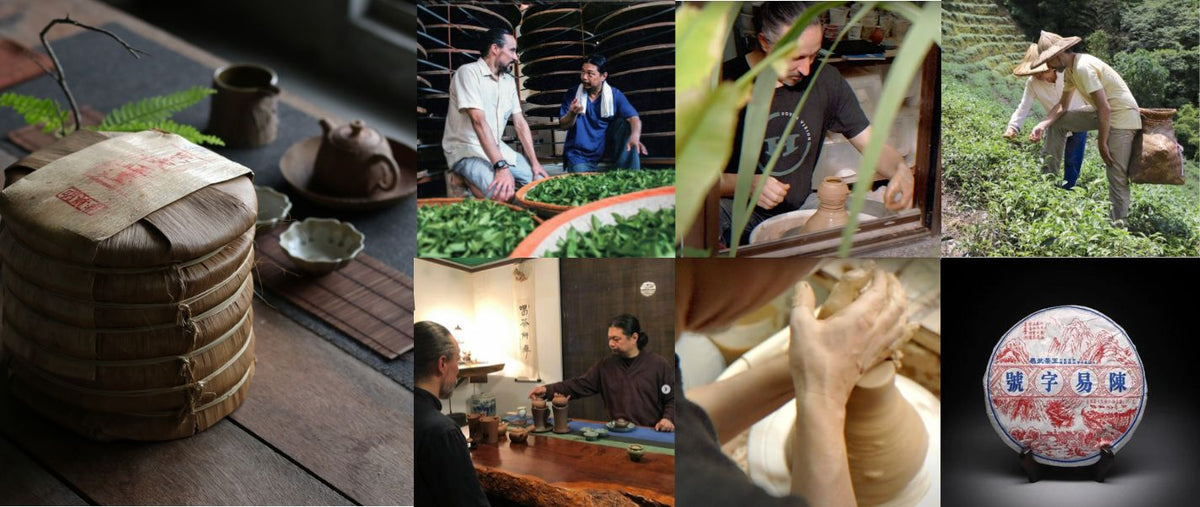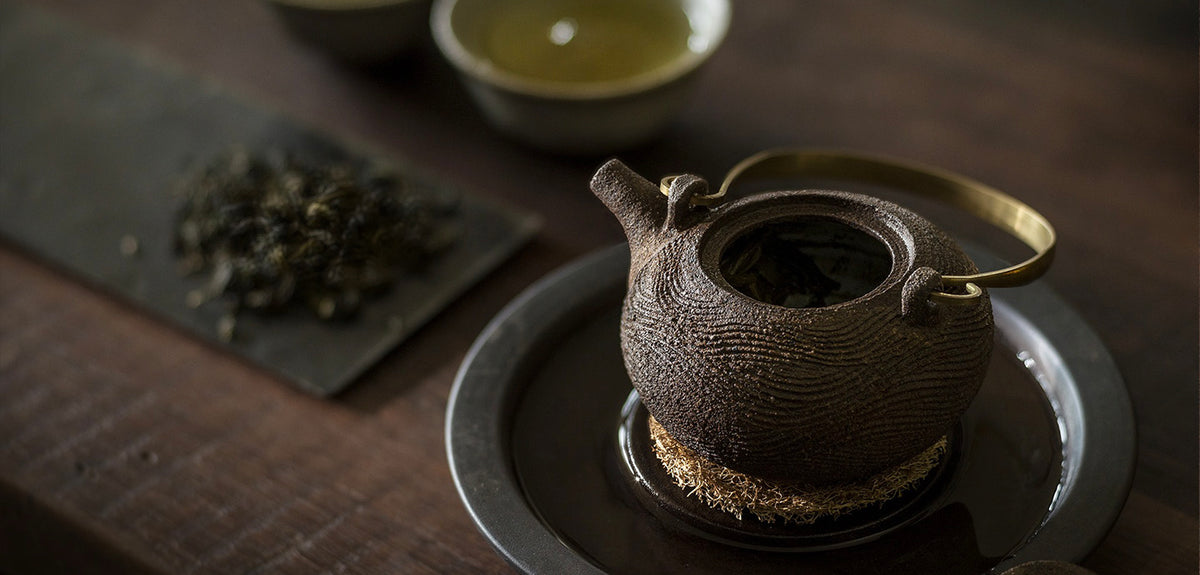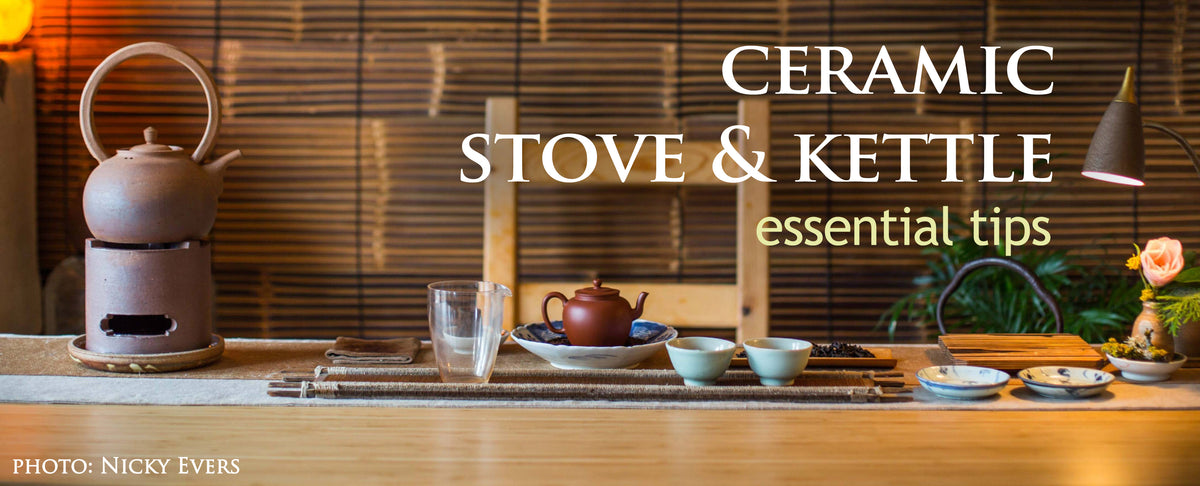Making our own tea

Making tea in Pinglin, Taiwan! We spent the morning picking tea from the mountainside, then spent all day making tea by hand, the traditional way. We didn't finish until 2am. Special thanks to Mr. Zhang the who guided us through the process and his family who helped us along the way. It was great to be in the countryside with such amazing, kind people. We each produced 1 kg of owr own tea!


Getting a little guidance from the master. — at Pinglin, Taiwan.

2 leaves and one sprout. This is what is typically used to make Chinese oolong tea. The stem is easily pinched off just beneath the second leaf, where it is still tender.

Mr. Zhang demonstrated that we must treat the leaves very gently as we spread them out on bamboo mats to be wilted in the sun. He then gave us each 4 bamboo mats with freshly picked tea leaves that would be our own batch of tea that we would each produce that day.

Our leaves were then briefly wilted in the sun for 10 minutes. The intense tropical sun was extremely hot so we had to move quickly at this stage to prevent the leaves from being burned. The temperature was at least 96 degrees.

Mr. Zhang stirring the leaves after about 5 minutes in the sun. He kept telling us to hurry up and finish this quickly so we could bring them inside for the next step indoor wilting. The whole process of sun wilting only lasted 10 minutes. After 5 minutes we had to quickly and gently turn the leaves in all 4 of our bamboo mats. It was not easy. Some of us were too slow and our leaves were burned in this stage. It was surprising that after years of growing under the sun, the leaves would burn in the sun within minutes of being picked.


After briefly being withered in the sun our leaves were brought indoors for indoor withering. You can already see that a considerable amount of moisture has evaporated from the leaves after only 10 minutes of sun withering in full tropical sun. Our bamboo mats were stacked on metal racks where they would spend the rest of the day wilting indoors.

Indoor withering. This is how we spent the majority of the day. After every hour we came into this room and gently fluffed the leaves with our hands. This action helped distribute the moisture so that the leaves would dry evenly at the same rate. This is also where the majority of oxidation takes place and the unique flavors of the tea develop. The room was full of the smell of fresh tea. Throughout the day the teas aroma developed. The fragrance of flowers, fruit and brown sugar filled the room later in the evening as the oxidation matured. Mr. Zhang taught us a lot during this process. He closely observed our movements. He questioned a few people about what was on their mind, and encouraged them to be more relaxed and focused on caring about the tea as we handled the leaves. He explained that the heart of the tea maker would be expressed in the tea during this period of indoor wilting and oxidation. The work done at this stage would determine the final quality and characteristics of the tea. He said our hands should move as if we were handling a baby, very delicately and lovingly. I admit I thought he was being overly esoteric about it. However, I was later proven wrong since by watching our movements during this process of indoor wilting he already predicted who's tea was going to turn out the best.
 After an amazing home cooked country style lunch which included Mr. Zhang's own free range chickens, bamboo grown on site, and fresh locally produced tofu from Pinglin we sampled some of Mr. Zhang's award winning tea. This one was his Alishan black tea which was sweet, fruity and outstanding when brewed in Sophie's vintage silver teapot. You wouldn't believe the price for this tea per jin (600g), so I won't mention it. But I will say that it was not cheap!
After an amazing home cooked country style lunch which included Mr. Zhang's own free range chickens, bamboo grown on site, and fresh locally produced tofu from Pinglin we sampled some of Mr. Zhang's award winning tea. This one was his Alishan black tea which was sweet, fruity and outstanding when brewed in Sophie's vintage silver teapot. You wouldn't believe the price for this tea per jin (600g), so I won't mention it. But I will say that it was not cheap!

Checking our tea later in the day. The room was full of wonderful fragrances. Our leaves had withered sufficiently and we consolidated 4 trays of tea into 3 fluffing the leaves every hour or so (between tea breaks. Later in the day when the leaves had wilted further we consolidated 3 trays to 2 then 2 to 1.

One of Mr. Zhang's free range chickens being free.

While our tea was withering indoors and before dinner we had time for another tea break down by the crystal clear stream that runs through Mr. Zhang's property. Three of the women participating in this event study cha dao with a tea master, two are ceramic artists and one is the owner of the famed Wisteria tea house in Taipei. So there was no shortage of great teaware. The one in the foreground is an antique silver teapot from which the tea was served in antique cups. The one in the background is a wood fired pot.

Sipping Mr. Zhang's award winning oolong tea outdoors during a hard earned break with the whole crew while our continues to oxidize indoors.

Fredrick a French Diplomat gets diplomatic with his tea leaves as he gently caresses his pile of partially withered leaves. It was around sunset. At this stage in production, our 4 mats of leaves were consolidated into 1 and the fragrance had developed from the earlier green grass scent to something more refined. Some batches were fruity, while others were floral, some even had the aroma of cane sugar. All of our tea had undergone the same process. The difference in fragrance was solely determined by the way makers hands handled the leaves through repeated stirring every hour during the oxidation process. At this point I was convinced by the truth of Mr. Zhang's earlier statement about the tea makers heart being reflected in the tea he produced. There were now vast differences in our individual batches of tea.

The tea we were making was Wuyi style rock tea from Qingxin oolong leaves. For this style of tea Mr. Zhang said three leaves and a sprout would work well for this tea. This helped since it was everyone's first time picking tea and we were pretty slow. Three leaves gave us more volume in a shorter amount of time. This picture was taken after a full day of indoor wilting just before we began the "kill green" process in which the leaves were heated in a large wok.

The dogs that barked at us basically the whole time we were there. I don't miss them!



Here the tea was piled in the center of the bamboo mat for final oxidation. You can see that a few of the leaves are brown and curled up. Those leaves were damaged being exposed to the sun for just a few minutes too long during the sun withering process.

Everyone with a sample of their best leaves ready for the tea tasting competition! The winner would be given 300g Mr. Zhang's prize winning Alishan black tea! A gift worth about $300 U.S.

The tea tasting competition. At this point the tea was in the final stages of oxidation, so it wasn't finished yet but most of the flavors had developed. Boiling water was poured over the unfinished tea leaves in bowls. Then we dipped porcelain spoons into the tea and smelled it to check the aroma. We were all surprised at how much the aromas varied in each batch of tea. Next we spooned a bit of tea into our cup to taste it. We all agreed that one tea had a better aroma and flavor than all the others. The lucky winner went home with 300g of Mr. Zhang's prize winning Alishan black tea and 600 grams of their own hand made tea. What a lucky girl!

The winner of the competition frying her tea during the "kill green" process. Funny enough she wasn't even much of a tea drinker. We all agreed that she very convincingly looked the part.

After frying the leaves are vigorously rolled on the bamboo mats to break down the cell structure of the leaves so the flavor will be released when boiled water is poured on them.

After frying and rolling the leaves were spread out on a small mat and put into a drying machine.

The two drying machines side by side. The one on the right is the first stage drying machine, the one on the left is the final dryer.

After some time in the dryer, the leaves were flipped and put back in the dryer to facilitate even drying.

This was the last and final stage. The leaves were put in a secondary dryer for final drying. After coming out the tea was done! Although it's not really done, since it still needs to rest for 3 months, then it can be roasted. Mine is resting now and I will roast it in 3 months in my bamboo tea roaster. I did try the tea when I got home and I was very happy with the results. Seeing how tea was made and participating in the whole process was a great experience. This experience makes me much more deeply appreciate having the luxury to drink a simple cup of good tea. It made me realize how much passion, effort and labor goes into making tea. I can see why this is a dying art as more people move to the city for higher paying less labor intensive jobs. Special thanks to Sophie for inviting me on this trip and to Mr. Zhang and his family for all their hard work and assistance and for preparing the great home cooked country meals we were treated to!
1 Response
Leave a comment
Comments will be approved before showing up.
Also in News

Sourcing and pricing

Modern, eco-friendly & Sustainable


Lucy
June 11, 2015
So cool!
Thank you for sharing this story, and the detailed process preparing quality oolong tea.
It seems the world of tea is endlessly fascinating. Always more to learn.
The connection here between the heart and the hands of the farmer/artisan and his relationship to the spirit of the land her fruits is just phenomonal.
Cheers!